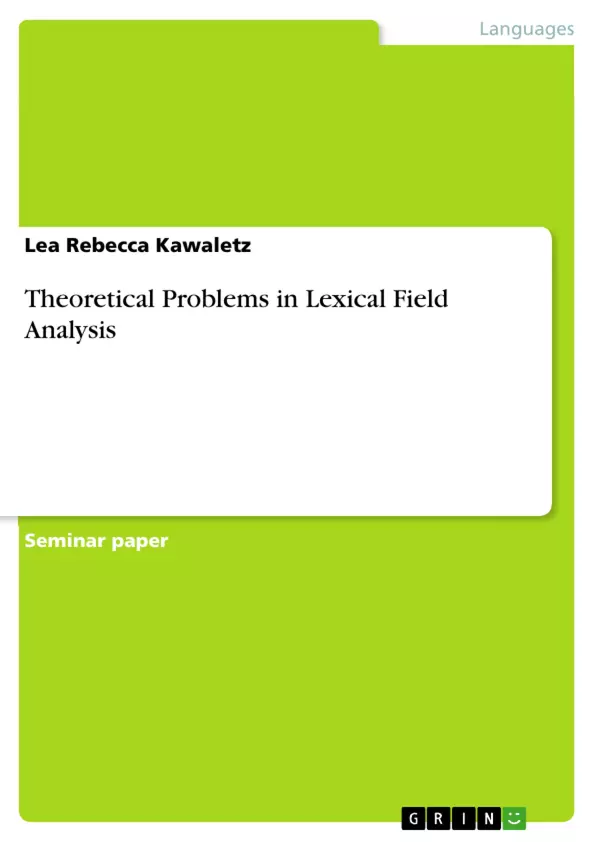While it has often been criticized, the notion of the lexical field can constitute a powerful tool in both intralingual and interlingual analysis. This paper provides a broad overview of topics which are relevant in the discussion of lexical field analysis. Afterwards, these topics will be brought into context by presenting a selection of outstanding approaches to field theory. Finally, the German word field tradition will briefly be compared to the parallel development in the USA.
Table of Contents
- 1 Introduction
- 2 Structuralism
- 2.1 The Saussurean Dichotomies
- 2.2 Componential Analysis
- 2.3 Sense Relations
- 3 Relativism and Functionalism
- 4 The Development of Lexical Field Theory
- 4.1 Trier and Weisgerber
- 4.2 Porzig
- 4.3 Coseriu
- 5 Folk Taxonomies
- 6 Criticism
- 7 Conclusion
- 8 Works Cited
Objectives and Key Themes
This paper aims to provide a broad overview of lexical field analysis, examining its origins in structuralist thought and its subsequent development. It explores various approaches to field theory, highlighting key figures and their contributions. The paper also touches upon criticisms leveled against the concept of lexical fields.
- The origins and development of lexical field theory.
- The influence of structuralism on lexical field analysis.
- Key figures and their contributions to lexical field theory (Trier, Weisgerber, Porzig, Coseriu).
- Different approaches to defining and analyzing lexical fields.
- Criticisms of lexical field theory.
Chapter Summaries
1 Introduction: This introductory chapter sets the stage by presenting the concept of lexical fields and their significance in linguistic analysis. It highlights the systematic nature of language and the various terminologies used in the field, clarifying the paper's focus on lexical fields in their broadest sense. The chapter also briefly outlines the paper's structure and its goal of providing a comprehensive overview of lexical field analysis, including historical development and key theoretical approaches.
2 Structuralism: This chapter delves into the foundations of lexical field analysis within the structuralist tradition, particularly highlighting the work of Ferdinand de Saussure. It emphasizes the interconnectedness of linguistic units and their relational meaning, contrasting with individualistic cognitive approaches. Saussure's key dichotomies—langue/parole, signifier/signified, syntagmatic/paradigmatic, and synchronic/diachronic—are explained in detail, showcasing their relevance to lexical field analysis. The chapter uses examples to illustrate how these structuralist concepts manifest in the study of lexical fields and the organization of vocabulary.
Keywords
Lexical field analysis, structuralism, Saussure, componential analysis, sense relations, Trier, Weisgerber, Porzig, Coseriu, semantic field, conceptual field, word field, meaning, linguistic meaning, systematicity of language.
Frequently Asked Questions: A Comprehensive Overview of Lexical Field Analysis
What is the main topic of this text?
This text provides a comprehensive overview of lexical field analysis, tracing its origins in structuralist thought and its subsequent development. It explores various approaches, key figures, and criticisms of the concept.
What topics are covered in the Table of Contents?
The Table of Contents includes: Introduction, Structuralism (including Saussurean Dichotomies, Componential Analysis, and Sense Relations), Relativism and Functionalism, The Development of Lexical Field Theory (covering Trier, Weisgerber, Porzig, and Coseriu), Folk Taxonomies, Criticism, Conclusion, and Works Cited.
What are the main objectives and key themes of the text?
The text aims to provide a broad overview of lexical field analysis, examining its origins in structuralist thought and subsequent development. Key themes include the origins and development of lexical field theory, the influence of structuralism, key contributors (Trier, Weisgerber, Porzig, Coseriu), different approaches to analyzing lexical fields, and criticisms of the theory.
What is covered in the chapter summaries?
The chapter summaries provide a brief overview of each chapter's content. The introduction sets the stage, defining lexical fields and their importance. The structuralism chapter delves into the foundations of lexical field analysis within structuralist thought, focusing on Saussure's work. Further chapters detail other perspectives and criticisms.
Who are the key figures mentioned in the text?
Key figures discussed include Ferdinand de Saussure (founder of structuralism), and leading figures in the development of lexical field theory: Trier, Weisgerber, Porzig, and Coseriu.
What are the key concepts explained in the text?
Key concepts explored include: lexical field analysis, structuralism, Saussurean dichotomies (langue/parole, signifier/signified, syntagmatic/paradigmatic, synchronic/diachronic), componential analysis, sense relations, semantic field, conceptual field, and word field.
What are the keywords associated with this text?
Keywords include: Lexical field analysis, structuralism, Saussure, componential analysis, sense relations, Trier, Weisgerber, Porzig, Coseriu, semantic field, conceptual field, word field, meaning, linguistic meaning, systematicity of language.
What type of audience is this text intended for?
The text appears geared towards an academic audience, particularly those studying linguistics, semantics, or related fields. The detailed analysis and theoretical framework suggest a familiarity with linguistic concepts.
- Arbeit zitieren
- B.A. Lea Rebecca Kawaletz (Autor:in), 2012, Theoretical Problems in Lexical Field Analysis, München, GRIN Verlag, https://www.grin.com/document/197277



